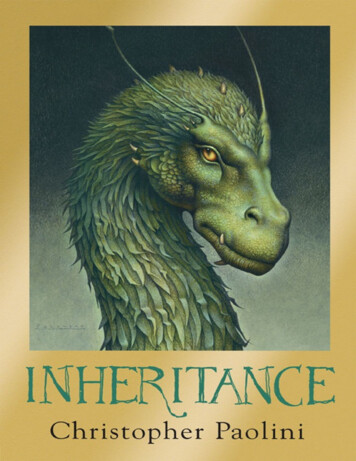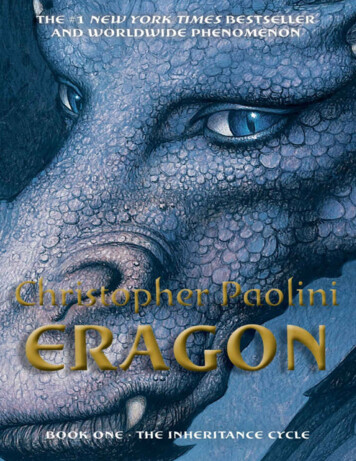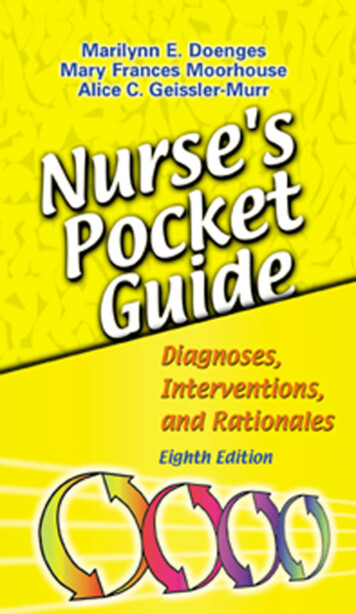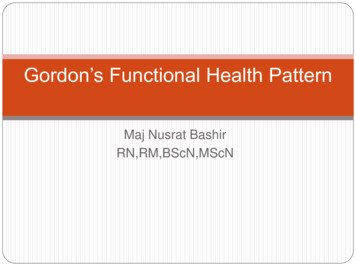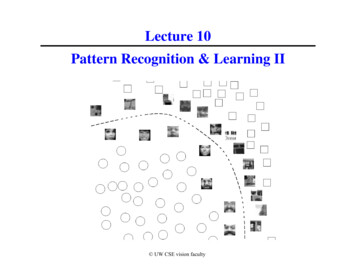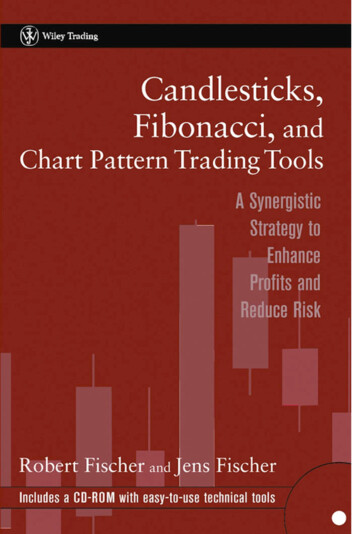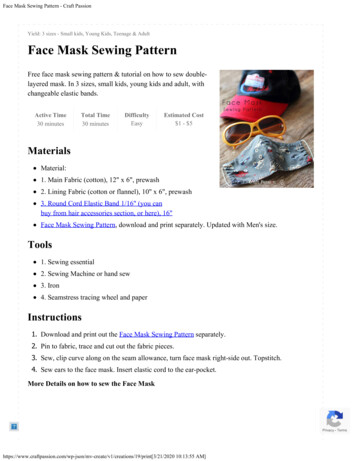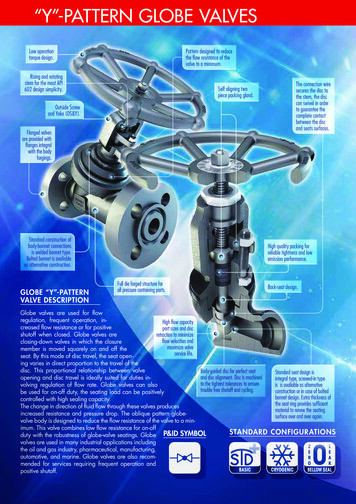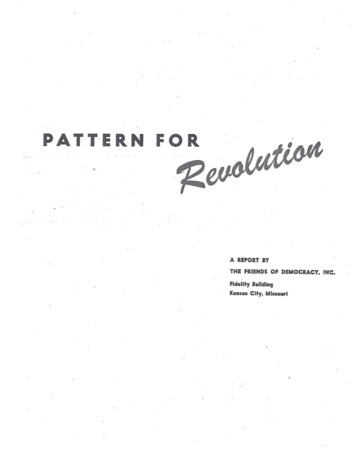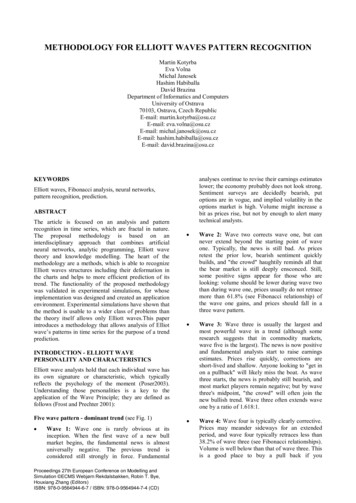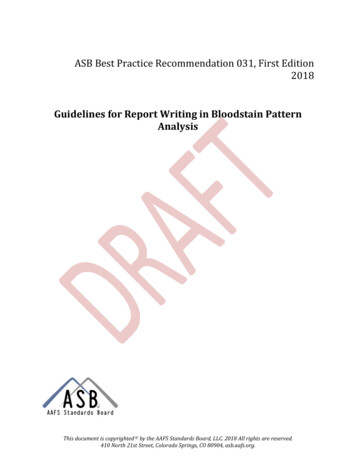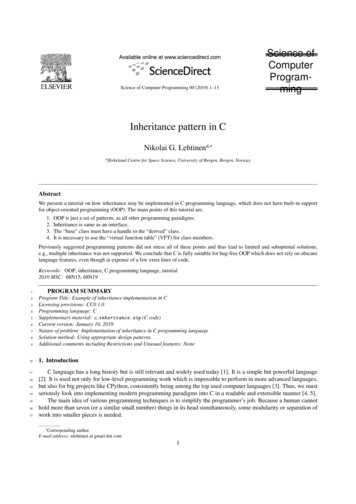
Transcription
Science of Computer Programming 00 (2019) 1–13Science ofComputerProgrammingInheritance pattern in CNikolai G. Lehtinena, a BirkelandCentre for Space Science, University of Bergen, Bergen, NorwayAbstractWe present a tutorial on how inheritance may be implemented in C programming language, which does not have built-in supportfor object-oriented programming (OOP). The main points of this tutorial are:1.2.3.4.OOP is just a set of patterns, as all other programming paradigms.Inheritance is same as an interface.The “base” class must have a handle to the “derived” class.It is necessary to use the “virtual function table” (VFT) for class members.Previously suggested programming patterns did not stress all of these points and thus lead to limited and suboptimal solutions,e.g., multiple inheritance was not supported. We conclude that C is fully suitable for bug-free OOP which does not rely on obscurelanguage features, even though at expense of a few extra lines of code.Keywords: OOP, inheritance, C programming language, tutorial2010 MSC: 68N15, 68N191234567891011121314151617PROGRAM SUMMARYProgram Title: Example of inheritance implementation in CLicensing provisions: CC0 1.0Programming language: CSupplementary material: c inheritance.zip (C code)Current version: January 16, 2019Nature of problem: Implementation of inheritance in C programming languageSolution method: Using appropriate design patternsAdditional comments including Restrictions and Unusual features: None1. IntroductionC language has a long history but is still relevant and widely used today [1]. It is a simple but powerful language[2]. It is used not only for low-level programming work which is impossible to perform in more advanced languages,but also for big projects like CPython, consistently being among the top used computer languages [3]. Thus, we mustseriously look into implementing modern programming paradigms into C in a readable and extensible manner [4, 5].The main idea of various programming techniques is to simplify the programmer’s job. Because a human cannothold more than seven (or a similar small number) things in its head simultaneously, some modularity or separation ofwork into smaller pieces is needed. Corresponding author.E-mail address: nlehtinen at gmail dot com1
N.G. Lehtinen / Science of Computer Programming 00 (2019) 65662The point of programming languages is to prevent our poor frail human brains from being overwhelmedby a mass of detail. [6]There are various programming paradigms which describe such “modularity.” After thinking a bit, we realize thatevery paradigm is just a coding pattern. Even subroutines used to be a pattern once, but now they are part of virtuallyall programming languages [7]. Classes and objects in the object-oriented programming paradigm (OOPP) are alsopatterns. Classes are modules, and may be implemented as such in C. It is not necessary to simulate all of the OOfeatures down to syntax: e.g., it is completely unnecessary to put function pointers inside structs in order to simulatemethods, as was suggested, e.g., in [8, sec. 34.4]. The methods can be functions in the same module as the struct inquestion. In this paper, we adopt the following convention: instead of the usual C syntax object.function(arg)where object belongs to a Class, we use C syntax ClassFunction(object,arg). Declarations of such functions arein Class.h, and definitions are in Class.c (usually).We are going to discuss the C implementation of the OOPP inheritance pattern. We must admit that we do notclaim complete originality of the ideas presented here. In particular, we draw on ideas presented in the implementationof the Reactor pattern in [4, part 5]. We strongly recommend the book [4] to the reader, as it demonstrates the power ofC language and its competitiveness in the modern industry with languages that are allegedly more advanced becausethey already have the OOPP set of patterns built into them.We treat the “inheritance” pattern the same as an “interface.” It is often recommended that “derived” classesshould inherit only from abstract classes which thus serve as “interfaces.” In order to extend a concrete class (usuallyfor the purpose of code re-use), another pattern is usually recommended, namely “composition” [9]. The “base”class is included as a member of the “derived” class and the method calls on the “derived” class are forwarded (ordelegated) to the “base.” Thus, we have to be very careful in order not to abuse the inheritance capabilities when theyare available.Availability of these alternatives leads to different approaches to inheritance in different computer languages. E.g.,Java, beside syntax for inheritance, also has separate syntax for interfaces. To avoid conflicting inherited implementations, it does not allow multiple inheritance. However, it still allows multiple interfaces [10].Abusing inheritance may lead to a complicated or inconsistent code. An example of bad usage of subtyping(inheritance), in our humble opinion, can even be found in the classical C book [11, Section 3.2.4]:A smiley face is a kind of a circle.We should check it against the Liskov substitution principle [12]:Subtype Requirement: Let φ(x) be a property provable about objects x of type T. Then φ(y) should be truefor objects y of type S where S is a subtype of T.We find that the properties φ1 “does not have eyes” and φ2 “does not have a mouth” are valid for a “circle” but notvalid for a “smiley face.” Thus, a “smiley face” is not a subtype of a “circle.” In theory, this can be fixed if we definethe type “circle” to have a property ψ “has something inside,” where the “something” is just “nothing” for a propercircle but substituted for “mouth and eyes” for the “smiley face.” But when we write the “circle” class, are we reallygoing to have so much foresight as to guess that we should allow it to have something inside it? Maybe the class fromwhich the “smiley face” inherits should be called not “circle” but something like “round thing,” which leaves morefreedom for interpretation. Then both “circle” and “smiley face” can inherit from the “round thing.”A similar noncompliance with Liskov substitution principle is committed in [13, ch. 4] where a subclass Circle isderived from a base class Point. A circle is definitely not a point! If we have a collection of various shapes like circlesand rectangles, and we want to store them in an array with uniform access, is it really an array of points?These examples show us that we should be careful when choosing inheritance over composition, and even thegiants of the computer world are not immune to errors. In Section 2.3 we provide a C example of a Smiley classwhich does not inherit from Circle but delegates function SmileyGetRadius to a member circle.Inheritance pattern implementation (as an interface) presented in this paper differs from many similar implementations that can be found on the internet. An important concept that we implement but which is completely ignoredby others, is that the interface (base) must have the handle of the (derived) object, in order to have access to objectspecific functions and members. Some authors [14, 15] go around this by using so-called type punning [16], i.e.,implementing base and derived objects in such a way that they occupy the same space in memory, thus forming a kind2
N.G. Lehtinen / Science of Computer Programming 00 (2019) 1–13373of a union. Type punning is widely used in projects, e.g., in GTK [17]. However, it intimately depends on how Cinterprets structs and may be subject to bugs [18]. Moreover, type punning allows only a single base and is thereforeincompatible with multiple inheritance.Unlike the type-punning approach [14, 15], we do not consider the “derived” objects to be objects of the “base”class, so we never perform true typecasting between the derived and base objects. (However, some analogy to typecasting is discussed in Section 3.) The difference in types is obvious if we think of the “base” in terms of an interface—thereal object, of course, is not of the interface class. Therefore, our approach is more logical.742. An example of an inheritance pattern in C67686970717289Attached to this article, there is a C code example with the described implementation. The compilation instructionsare given in the comments in the beginning of file main.c. Below, we go through the details of what the code exactlydoes.Consider a program that deals with various planar shapes, like Circle, Rectangle, etc. One can find featureswhich may be attributed to all of the different kinds of shapes, e.g., the position on the plane (x, y) or color with whichthe shape is drawn. The various shapes also have an area and a perimeter, which are calculated in a different mannerfor different types. All of the common features may be put in a base class, or an interface, which we call Shape. TheShape part provides a uniform way of accessing the instances of derived classes. For example, we can create an arrayof Shapes which are actually interfaces to more complicated derived class instances. By iterating over this array, wedraw different shapes and calculate their areas and perimeters. An appropriate method will be called for each object(another way to say in OOP terminology is that each object receives a message). Thus, we do not have to worry aboutdetermining the objects’ respective classes during the iteration.We do not include in the text of this paper the discussion of various functions which are present in the attachedcode but should only be used for debugging, or to demonstrate bad programming practices. In the code, these partsare accompanied by appropriate warnings.902.1. The interface class Shape75767778798081828384858687889192There are two levels of availability of details of this class to the outside world: for the end user and for the derivedclasses. These two levels correspond to the public and protected levels in C , correspondingly.942.1.1. Public membersThe user access is described in Shape.h. The implementation details are hidden in an abstract data type (ADT):95// A shortcut for the handle196typedef struct ShapeInterfaceT *Shape;293979899100101102103104We will return to discussing struct ShapeInterfaceT in the next Subsubsection.In all functions below the argument of type Shape can be either of the derived or the pure-base type. By pure-baseobject we mean an interface without an initialized derived-object part. The user is provided with public constructorand destructor which must be called explicitly:// Constructor and destructor// ”New” calls should match ”Delete” ”Replace” calls to prevent memory leaksShape ShapeNew(float x, float y);void ShapeDelete(Shape *shapePtr); // sets shapePtr to NULL106We also provide an analog of the copy-assignment operator in C which replaces an old value with the new, therebydeleting the old value:107void ShapeReplace(Shape *old shapePtr, Shape new shape);105108109110111In order to prevent memory leaks, all ShapeNew operations should match corresponding ShapeDelete or ShapeReplaceoperations, which will be clear from the implementation details.The user interface is provided by a set of functions. Here are object member access functions (getters and setters,e.g. for coordinates):312341
N.G. Lehtinen / Science of Computer Programming 00 (2019) 1–13112// 1. Getters and setters for data members1116floatfloatvoidvoid117We can also access class members (common for a whole base or derived class):118// . and for class pe, float new x);shape, float new y);23451char *ShapeGetClassName(Shape shape); // to demonstrate a class data member, NOT to do any dispatch over subclasses!int ShapeCounterOfThisType(Shape shape); // virtual class method (?) Determines class by an instance.23128These functions determine the class of the given instance shape and return an appropriate class data member. If theclass is the base class (shape is a pure-base object), the first function returns "Shape" and the second function returnsthe total number of interfaces (sum of the numbers of all derived plus pure-base objects). If the class is a derived class,these functions correspondingly return an appropriate name (e.g., "Circle", "Rectangle" etc) and the total numberof relevant objects (circles, rectangles, etc).It is possible to access class members for a given class, too. Such functions do not need an instance (object),but the class name has to be specified explicitly in the name of the function. E.g., the counter of all Shapes may beaccessed with129// in Shape.h1130int ShapeCounterTotal(void); // class method2121122123124125126127132which does not need a pure-base shape as an argument.Finally, there are methods:133// 2. Methods (interfaces to overloaded virtual methods)1311136float ShapeArea(Shape shape);float ShapePerimeter(Shape shape);void ShapeDraw(Shape shape,int color);137// A method which is not a bare interface5138void ShapeTranslation(Shape shape, float dx, float dy);6134135139140141142143234The functions for area and perimeter calculation and drawing a shape are overloaded by subclasses so they can beconsidered virtual functions. If shape is a pure-base object, the call to a virtual function causes an error, and if it is aderived-class object, an appropriate overloaded function is called. The last function, ShapeTranslation, utilizes onlyinformation available in the base class. Its code is thus fully provided by the base class Shape, and is not overloadedby any of the subclasses. Therefore, it cannot be called a virtual function.1472.1.2. Protected membersThe struct ShapeInterfaceT is implemented in ShapeProtected.h, a file which is used by derived classes, butthe end user does not have access to. The implementation details are thus hidden from the user completely, whichresembles what is known as “pimpl” idiom in C [19, Item 22]. The struct has the following fields:148// The implementation struct must be available to derived classes1149struct ShapeInterfaceT {2144145146153// 1. The access to the derived object, or equivalently, the object using the interfacevoid *instance; // must be void because we don’t know its type yet// Interface elements// 2. Object members (usually, data members which are non virtual by their nature)154float x, y;7155// 3. Class members: data and methods.8156struct ShapeClassMembers *vft; // all interface methods collected in a virtual function table9150151152157158159}345610The pointer instance provides the access to the derived object (or, equivalently, the object which uses the interfaceShape). Its type is not known in advance, so we have to use void *. Next, there are instance data members float x, y,4
N.G. Lehtinen / Science of Computer Programming 00 (2019) 1–13160161162163164which are individual for each object. Finally, there is a field that provides access to class data members and methodsstruct ShapeClassMembers *vft, which is called (mostly for historical reasons) a virtual function table (VFT, [20]).If we want to track class data members which change their values, it is necessary to introduce VFT because thesecannot be stored in struct ShapeInterfaceT which is individual to each instance of a class. A VFT is common forthe whole class (base or derived) and stores all the class members. It is implemented as171struct ShapeClassMembers {char *class name; // class data member (”static” in C )int obj counter;float (*area)(void* instance);float (*perimeter)(void* instance);void (*draw)(void* instance, int color);void (*destruct)(void 12345678There are class data members char *class name, int obj counter and methods area, perimeter, draw, destruct. The methods are virtual functions, which become concrete functions when a derived class is defined, and areaccessed by the user through ShapeArea etc., provided in Shape.h. In principle, we can also have methods (functions) which are specific to an instance (something like a derived singleton class), which have to be stored in structShapeInterfaceT, but we do not have them in this example.1792.1.3. Implementation details (private members)The methods of the abstract Shape class are implemented in file Shape.c. The creator of the Shape looks like this:180static void ShapeReset(Shape shape) {1782shape- instance NULL;shape- vft &ShapeVFT;1821831841// Auxiliary function18134}51851861871881891901911921936// ”New” calls like this should match ”Delete” ”Replace” calls7Shape ShapeNew(float x, float y) {Shape shape malloc(sizeof(struct ShapeInterfaceT));ShapeReset(shape);shape- vft- obj counter ; // counting virtual shapes onlyshape- x x; shape- y y;return shape;}197The object counter increment here shape- vft- obj counter applies to the base class. Another advantage of usingVFT is that we do not need to copy all the class members and function pointers into each new object created, but onlycopy the address of the singleton ShapeVFT.This VFT stores the pure-base class members and methods:198static struct ShapeClassMembers ShapeVFT {194195196200201202203204205};The placeholder functions VirtualShapeArea etc., are implemented in order to avoid segfaults if the virtual functions are called by mistake. For example:208static float VirtualShapeArea(void *instance) {2091011121314234567820720691.class name "Shape", // or could be just NULL.obj counter 0, // we count the virtual shapes separately.area VirtualShapeArea,.perimeter VirtualShapePerimeter,.draw VirtualShapeDraw,.destruct VirtualShapeDestruct19981fprintf(stderr,"error: call to virtual function ShapeArea\n");52
N.G. Lehtinen / Science of Computer Programming 00 (2019) 1–13return 0.;21021163}4217Their output may be used for diagnostics instead of just terminating the execution. (Exiting on error is turned onwith make OPT -DEXIT ON VIRTUAL CALL when compiling the code.) If the Shape interface is not attached to anyconcrete (derived) class, then the instance argument of these virtual functions must be NULL, so that we can check it asan extra level of safety. (Checking for such internal consistencies is turned on with make OPT -DCHECK INTERNAL.)The virtual functions are declared as static and are invisible outside the file.The access functions available to the user are implemented as one-liners:218// Methods2122132142152162192202211float ShapeArea(Shape shape) { return shape- vft- area(shape- instance); }float ShapePerimeter(Shape shape) { return shape- vft- perimeter(shape- instance); }void ShapeDraw(Shape shape,int color) { shape- vft- draw(shape- instance, color); (Shapeshape)shape)shape,shape,{ return shape- x; }{ return shape- y; }float new x) { shape- x new x; }float new y) { shape- y new y; }char *ShapeGetClassName(Shape shape) { return shape- vft- class name; }int ShapeCounterOfThisType(Shape shape) { return shape- vft- obj counter; }int ShapeCounterTotal(void) { return ShapeVFT.obj counter; }238239void ShapeTranslation(Shape shape, float dx, float dy) {235236237shape- x dx; shape- y dy;printf("Moving shape by (dx %f, dy %f) to the new position at (%f, %f)\n", dx, dy, shape- x,shape- y);240241242243}246247void ShapeDelete(Shape *shapePtr) {// We don’t check if shapePtr is NULL, we should not use addresses to anything but Shape248Shape shape *shapePtr;if (!shape) { fprintf(stderr,"error: double delete of the shape interface\n"); exit(1); }void *inst shape- instance;if (inst) {shape- vft- destruct(inst); // destruct the derived partShapeReset(shape); // important, restore virtual shape class members} // if inst NULL, then it means that some other interface already destructed itshape- vft- obj counter--; // counting virtual shapes onlyfree(shape);*shapePtr NULL; // this way we can tell it does not point to anything 10121314151234The destructor of the interface Shape should take care of calling an appropriate destructor for the derived part ofthe class and freeing the memory occupied by the interface itself. The destructors for the derived parts are hiddenfrom the user. The reason for this is discussed in Section 3. The destructor is implemented in the following way:244245411// Class member accessThe usage of the instance pointer is completely hidden from the user. The only disadvantage of the VFT designpattern that we see here is that we have to perform an extra operation of dereferencing and member access, namelyshape- vft- area etc., which would not be needed if area were part of the struct ShapeInterfaceT *shape. However, this is far outweighed by the fact that the variable class members (like the object counters) are impossible withoutVFT.An example of a non-virtual method (i.e. one that does not use shape- vft):23323435// Data member access (getters and setters), making them available to the user2282292}The decrement applies to the base class because shape- vft is restored to point to ShapeVFT after destruction of thederived object part. The Shape which is passed to it by reference is changed to NULL in order to indicate that the object612345678910111213
N.G. Lehtinen / Science of Computer Programming 00 (2019) 1–137267has been destructed and to ensure that any future attempts to use it will give an error instead of a segfault. There ismore discussion of safe programming practices in Section 3. It is not an error when ShapeDelete is called without aderived part. Its absence could be due either to the fact that it was never created, or, in a more complicated case with“multiple inheritance”, i.e., multiple interfaces, that it had been destructed by another interface.Sometimes we need to replace an object, which includes the destruction of the old one. This is equivalent to theC copy-assignment operator:268void ShapeReplace(Shape *old shapePtr, Shape new shape) {262263264265266ShapeDelete(old shapePtr);*old shapePtr new shape;26927027127227327423}4For each malloc, there should be a free. Thus, each ShapeNew operation should have a matching ShapeDelete orShapeReplace. This will be our safe programming rule in order to avoid memory leaks. More safety rules arediscussed in Section 3.2762.2. A derived class, on the example of CircleThe publicly available info about Circle can be very limited. Here is what is in Circle.h:277#include "Shape.h"275127827912typedef struct CircleCDT *Circle;32804281// Access to the interface (base class)5282Shape CircleShape(Circle circle);6285// Derived class constructor when the base ”shape” is already constructed.// There is no need for matching destructor because the deletion of the// derived part is done automatically when the interface (base) is deleted286Circle CircleCreate(Shape shape, float radius);10287// Circle methods11283284288289290291292293294295296int CircleCounter(void); // class methodfloat CircleGetRadius(Circle circle);void CircleSetRadius(Circle circle, float new radius);#include "Shape.h"#include "ShapeProtected.h"#include "Circle.h"struct CircleCDT {56};7Shape CircleShape(Circle circle) { return circle- shape; }3053071The creation of the Circle object is done only after the underlying interface Shape has been created. It is implemented in the following way:Circle CircleCreate(Shape shape, float radius) {Circle circle malloc(sizeof(struct CircleCDT));// Attach the base (this must be in every derived class)123309if (shape) circle- shape shape;else { fprintf(stderr,"error: base not initalized in CircleCreate\n"); exit(1); }310shape- instance circle;308144302306133A simple access to the base-class part is provided by a one-liner which may be considered a typecasting operatorfrom the derived to the base class:30312230130491Shape shape;float radius;2983008The user-accessible Circle is an ADT, and the internals stored in the concrete data type (CDT) are not user-accessible.The implementation is in file Circle.c. The derived object stores the base plus its own members:29729974567
N.G. Lehtinen / Science of Computer Programming 00 (2019) 1–138311// Overload the inherited members (virtual functions)7312shape- vft &CircleVFT;8314// Done with preliminaries! Now, the proper initialization// 1. Do whatever is needed with derived class members315shape- vft- obj counter ;11316// 2. Initialize the derived object members12313circle- radius radius;printf("Creating a Circle at (%f, %f) of radius %f\n", shape- x, shape- y, radius);return circle;317318319320}321The VFT of the base class is replaced in the creator by the class’s own VFT:322static struct ShapeClassMembers CircleVFT {3243253263273283291013141516.class name "Circle",.obj counter 0, // not constant!.area CircleArea,.perimeter CirclePerimeter,.draw CircleDraw,.destruct CircleDestruct3239};12345678335The increment shape- vft- obj counter in the creator applies to the number of Circle objects because shape- vft points to CircleVFT. Since the creator takes a base object and returns a derived object, in may be looked at as atypecasting operator (which, however, takes additional arguments like radius).We implement concrete functions CircleArea, CirclePerimeter, CircleDraw and CircleDestruct using the appropriate signatures from the Shape interface. They are declared as static and are therefore not visible to the userdirectly, but are accessed through Shape’s interface. For example:336// This destructs only the derived additions1337static void CircleDestruct(void *instance) {2330331332333334341Circle circle (Circle) instance;Shape shape circle- shape;printf("Destructing circle at (%f,%f)\n", shape- x, shape- y);shape- vft- obj counter--;342// Could be more work, if anything extra was allocated in ”CircleCreate”7343free(circle);8344// Keep ”shape”, this method destructs only the ”derived” stuff9338339340345}351As we said, this destructor is hidden from the user and is only called by ShapeDelete (see the code in the previousSubsection). Notice the decrement shape- vft- obj counter-- which only applies to the number of Circle objectsbecause shape- vft points to CircleVFT. An explicit destructor of a Circle may be dangerous because the shapemember inside it may have other references to it which cannot be updated to have a NULL value. It is necessary to haveonly a single useable reference to each Shape object for safe programming, as discussed in Section 3.We have access to the total number of instances of a given derived class:352int CircleCounter(void) { return CircleVFT.obj counter; }346347348349350353354355356357358359360It is also possible to access it with int ShapeCounterOfThisType(Shape shape) if shape is an interface to a Circle.Other derived classes implemented in the attached code are Rectangle (which is also rather simple, like Circle;calculations of the area and perimeter have, of course, different implementations), and Smiley, about which in detailin the next Subsection.2.3. The Smiley class: both composition and interface/inheritanceThe Smiley class is also derived from Shape and the code for it has the same pattern as Circle. As suggested inSection 1, it is not a derived class of the Circle class. Instead, we use composition, and store the big circle as memberface:83456101
N.G. Lehtinen / Science of Computer Programming 00 (2019) 1–13361362363// This is in Smiley.c1#define NFACEELEM 4struct SmileyCDT {23Shape shape;Shape elements[NFACEELEM]; // Face, eyes and mouthbool isForeground[NFACEELEM]; // true if foreground, false if backgroundCircle face; // composition over inheritance!Circle eyes[2];Rectangle mouth;3643653663673683693709456789};10374(The bool type is defined in stdbool.h .) In Smiley.h we have, of course, the ADT definition typedef structSmileyCDT *Smiley.Instead of inheriting the Circle methods, we delegate them to the member face. However, this is not alwayspossible. In the user-accessible Smiley.h we have375// Circle methods3713723731377float SmileyGetRadius(Smiley smiley);void SmileySetRadius(Smiley smiley, float new radius);378In the implementation Smiley.c we have a one-liner delegating the functionality to a member:376380float SmileyGetRadius(Smiley smiley) {return CircleGetRadius(smiley- 3The code for the setter SmileySetRadius would not be, however, a simple one-liner like this because all the facialelements need to be resized and re-positioned when the radius of the face is changed. Code re-use, which we get bydefault with inheritance, is impossible here. This function is not yet implemented in the current version of the code,and the reader may do it as an excercise.In the constructor, we create each facial feature. When we create the eyes and the mouth, we just scale them bythe given overall size radius:Smiley SmileyCreate(Shape shape, float radius) {int i;double x, y;Smiley smiley malloc(sizeof(struct SmileyCDT));1234// Attach the base (this must be in every derived class)5394if (shape) smiley- shape shape;else { fprintf(stderr,"error: base not initalized in SmileyCreate\n"); exit(1); }395shape- instance smiley;8396// Overload the inherited members (virtual functions)9397shape- vft &SmileyVFT;1039367399// Done with preliminaries! Now, the proper initialization// 1. Do whatever is needed with derived class members400shape- vft- obj counter ;13401// 2. Initialize the derived object members143981112407x shape- x; y shape- y;printf("Creating a Smiley at (%f, %f) of radius %f\n", x,smiley- face CircleCreate(ShapeNew(x, y), radius);smiley- eyes[0] CircleCreate(ShapeNew(x - radius/3.,y),smiley- eyes[1] CircleCreate(ShapeNew(x radius/3.,y),smiley- mouth RectangleCreate(ShapeNew(x, y-radius/2.),408// Associate the shapes with elements40240340440540640941
42 tations, it does not allow multiple inheritance. However, it still allows multiple interfaces [10]. 43 Abusing inheritance may lead to a complicated or inconsistent code. An example of bad usage of subtyping 44 (inheritance), in our humble opinion, can even be found in the classical C bo
